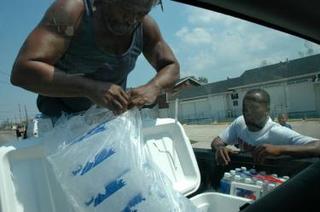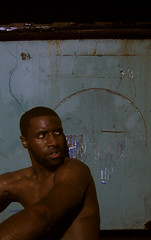Eyewitness Report from New Orleans
On Saturday September 3, award-winning filmmaker Gloria La Riva, internationally-acclaimed photographer Bill Hackwell and A.N.S.W.E.R. Youth & Student Coordinator Caneisha Mills, a senior at Howard University, arrived in New Orleans.
The following is an eyewitness report of the crisis in the area written on Sunday, September 4.

Algiers
While 80 percent of New Orleans was submerged in water, Algiers is one of the few districts that have been spared the worst of the flooding as it sits higher than most of the city. An historic district established in 1719, Algiers is on the west bank of the Mississippi river, across from the French Quarter. Probably 15% of the residents still remain behind, most of them determined to stay in their homes. The majority of homes are still intact, although many have suffered damage. While their houses survived, the peoples’ chance of survival seemed very bleak since there was no electricity or disbursement of food, water or other supplies.
We arrived in the Algiers district of New Orleans after getting through seven checkpoints. We quickly learned that the current media reports that relief and aid have finally arrived to New Orleans are as false as all earlier reports that also had as their origin government sources. The people in the Algiers area have received nothing or next to nothing since the Hurricane struck. Left without any way to escape, people are now struggling to survive in the aftermath. Now they are being told they have to abandon their homes, even though they want to stay. They are not being given what they need to stay and survive, and are being told they must leave.
“Imagine being in a city, poor, without any money and all of a sudden you are told to leave and you don’t even have a bicycle,” stated Malik Rahim, a community activist in the Algiers section of New Orleans. “90% of the people don’t even have cars.”
One woman told us it was not possible for her to evacuate. She said, “I can’t leave. I don’t have a car and I have nine children.” She and her husband are getting by with the help of several men in the community who are joining resources to provide for their neighbors.
The government claims that people can get water, but residents have to travel at least 17 miles  to the nearest water and ice distribution center. Only one case of water is available per family. Countless people have no way to drive.
to the nearest water and ice distribution center. Only one case of water is available per family. Countless people have no way to drive.
While the government is touting the deployment of personnel to the area, there is a huge military and police presence but none of it to provide services. All of them, north and south of the river, are stationed in front of private buildings and abandoned stores, protecting private property.
The goods that the government personnel are bringing in are for their own forces. They are not distributing provisions to people who desperately need them.
Not one of them has delivered water to Algiers or gone to the houses to see if sick or elderly people need help. There is no door-to-door survey to see who was injured.
The overwhelming majority of people who have stayed in Algiers are Black but some are white. One man in his late 50s in Algiers pointed across the street to a 10-acre grassy lot. It looks like a beautiful park. He said, “I had my daughter call FEMA. I told them I want to donate this land to the people in need. They could set up 100 tractor trailers with aid, they could set up tents. No one has ever called me back.” He is clearly angry.
Although some of the residents do express fear of burglaries into houses, acts of heroism, sacrifice and solidarity are evident everywhere.
Steve, a white man in his 40s, knocks on Malik’s front door. He tells us, “Malik has kept this neighborhood together. We don’t know what we’d do without his help.” He has come in because he needs to use the phone. Malik’s street is the only one with phones still working.
Malik and three of his friends have been delivering food, water and ice to those in need three times a day, searching everywhere for goods.
There is a strong suspicion among the residents that the government has another agenda in the deliberately forced removal of people from Algiers, even though this particular neighborhood is not under water and is intact.
Algiers is full of quaint, historic French-style houses, with a high real estate value, and the residents know that the government and real estate forces would like to lay their hands on their neighborhood to push forward gentrification which is already evident.
---
To read the full article, including reports on Downtown New Orleans, New Orleans International Airport and Baton Rouge, click here.
To read Malik Rahim's article "This is Criminal", click here.
To take action, click here to tell Bush and Congress to accept Cuba's offer to send medical personnel.




<< Home